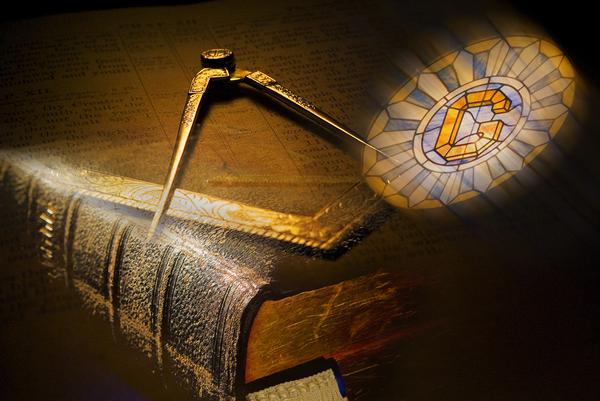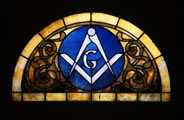




What is Masonry?
Ancient, Free, and Accepted Masonry is not a religion, a cult, a conspiracy, nor even a secret society. We are, in fact, the oldest and largest fraternal organization on the planet, dedicated to making good men better. We serve in our communities. We give generously to good causes. We found hospitals, elders homes, and charities. We teach philosophy and ethics. Most of all, we strive to live lives of virtue to improve both ourselves and our communities.
We come from all walks of life to meet upon the level. We are not a religion, though we do believe in God—for how else can we talk about goodness, truth, and beauty? We are not a secret society, though we do have a few secrets—if only to make sure that we know how to keep confidence and tame our tongues. We are not a cult, though we strongly encourage all of our members to pursue religious lives—because while Masonry is a school of reason, we acknowledge the necessity of revelation and religious faith. Grace, after all, perfects nature.
We are men who want to be better men; to study classical virtues; both to embrace democratic values of equality and also to respect proper hierarchies of authority. We never interfere with any man’s responsibilities to his family, nation, or God. If you’d like to know more, by all means, ask us about our fraternity. Contrary to popular opinion, we’re really quite eager to talk about Masonry, and to dispel any misunderstandings. We are builders, teachers, neighbors, and fathers. We are Masons.
Yours Fraternally,
Kenny Friese
Master, Perham Lodge #157
Barfield’s Phases
A LEO Talk
Last century there lived a British philosopher named Owen Barfield. He wasn’t terribly famous, but he had some famous friends: namely, C.S. Lewis and J.R.R. Tolkien. And Barfield had a remarkable theory regarding the spiritual predicament of our age. He realized that human consciousness evolves over time, by which he meant that all societies go through phases of self-understanding and broadening awareness.
More specifically, he said there are three of these phases: original participation, withdrawal from participation, and reciprocal participation. But don’t get hung up on the terminology. It’s really a quite elegant and insightful idea.
The first of Barfield’s phases is original participation. A society at this phase does not draw sharp distinctions between the individual and the community, the inner life and the outer life, the natural and the supernatural, history and myth. Rather, everything intermingles. When the Bible uses the same word for spirit, wind, and breath, that’s original participation. When you go to a sports game and get swept up in the crowd, in the cheering, in the communal exaltation, that’s original participation. We surrender ourselves to the whole and take a step back in time.
The next phase Barfield called withdrawal from participation. It happens when there’s a shift in societal awareness such that we are pulled out from the whole. We are no longer entirely immersed in the life of others and of nature and the gods. We become aware of an interior self that is, relatively speaking, our own. We begin to ponder the great questions of life, the universe, and everything, seeking answers not without but from within. We grow skeptical of societal norms and taboos.
By its very nature, this second phase is often experienced as a severing or separation, even as an isolation, and that indeed is a high price to pay. Think of Odin’s eye, sacrificed for wisdom. But the benefits are equally profound: withdrawal from participation allows us to discover moral responsibility, philosophy, and a deeper understanding of the divine.
This leads us, then, to the third of Barfield’s phases: reciprocal participation. At this stage, people come to realize that the discoveries of phase two—that deeper understanding of morality, philosophy, and God—must now be incarnated in the world. These truths cannot remain pure theory but must become example. Phase three is the conscious choice to take what withdrawal taught us, what the interior life taught us, and to return with it into society to live out these truths for others. In other words, the purpose of the mountaintop experience is to come back down.
If wisdom is the recovery of innocence at the far end of experience, then that’s what this third phase is. People at this stage can forge purposes and intentions. The awareness of participating in communal life still involves shared rites and ceremonies, but these are now undertaken freely and consensually, not simply because some priest or king demands it. It is the best of both worlds: the synthesis of the individual and the whole, the inner and the outer, the sacred and the secular, God and Man. Here is where true life dwells.
Keep in mind, however, that these phases are not linear, not once-and-done, but cyclical. Societies slide back and forth in their awareness, ever changing, never static. You can see this unfold in the Bible, for instance, in its repeating pattern of exile and return. I could offer further examples from ancient Greece, or the Middle Ages, or even the life of the Buddha. But I think just one more will suffice. And that is the example of our own time and the spiritual crisis our society faces today.
See, a hundred years ago everything was all about nationalism, and nation-states were going gangbusters. Every day, in every way, things were getting better and better: new technologies, new discoveries, new conquests all over the globe. And every nation-state had its own little pet church, so that personhood, people, piety and patriotism all got mixed together into one big mishmash, a towering monolith of one people, one language, one faith, one destiny. That’s phase one writ large.
And all that came crashing down in the catastrophe of the twentieth century: World War I, World War II, the Cold War, the Atomic Age, the Holocaust, the Bloodlands, horror upon horror, so that we all recoiled; we all leapt back. We all retreated into individuality, collectively losing faith in our society, in our institutions: government, military, church, university, what-have-you. We withdrew from participation out of sheer and awful shock. That’s phase two.
And that’s where we are today: separated, isolated, consumed with becoming individuals just like everybody else; forever attempting to build ourselves up by selecting from a list of infinite choice available on Amazon and purchasable through PayPal. People don’t come to Church because people don’t come to anything. We’re still recovering from a societal collapse which began just over a century ago.
So Good News: if Barfield is right, then the next phase is reciprocal participation. People will need to reconnect. We will need to come out of isolation, come out of the exclusive self, and learn to live again, truly live, in connection with God, nature, and one another.
So what has all this to do with the Lodge? Consider, if you well, the work of the three degrees. An Entered Apprentice is welcomed into the Craft, into the fellowship, into the Brotherhood as one of our own. He learns to participate in Lodge society. As a Fellowcraft, he is then expected to focus within: to educate himself on the seven liberal arts and sciences, the orders of architecture, human anatomy and alchemical symbolism, the inner workings of body and soul.
At last comes the Master Mason, who leads by example, who embodies the truths of the Fellowcraft in the society of the Entered Apprentice, whose trowel binds together the inner and outer life with the cement of brotherly love. The Lodge is thus a microcosm of human society as a whole. For indeed, as above, so below.
LEO